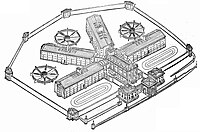Statistical correlations of criminal activity

Okay, imagine you have a bunch of friends at school. Sometimes, some of your friends might do things that are not very nice, like taking toys from other kids without asking or calling other kids mean names. These not nice things are like criminal activity when we grow up.
Now, let's say you notice that every time your friend Joe takes a toy without asking, your other friend Jane also takes a toy without asking. You might start to think that there is a connection between Joe and Jane's behavior, right? This connection between two things is called a correlation.
In real life, scientists and researchers look at data to see if there is a correlation between different types of criminal activity. For example, they might look at the number of burglaries that happen in a neighborhood and the number of drug arrests that happen in the same area. If they notice that when there are more burglaries, there are also more drug arrests, they might think that there is a correlation between those two things.
Of course, just because there is a correlation between two things doesn't necessarily mean that one causes the other. Going back to our example with Joe and Jane, maybe when Joe takes a toy, Jane gets mad and takes one too. Or maybe they both just happen to like taking toys without asking. It's important for scientists to do more research and think about other explanations before they say that one thing causes another.
Overall, looking for correlations in data about criminal activity can help us understand why certain things happen in different neighborhoods or cities, and how we might be able to prevent them.
Now, let's say you notice that every time your friend Joe takes a toy without asking, your other friend Jane also takes a toy without asking. You might start to think that there is a connection between Joe and Jane's behavior, right? This connection between two things is called a correlation.
In real life, scientists and researchers look at data to see if there is a correlation between different types of criminal activity. For example, they might look at the number of burglaries that happen in a neighborhood and the number of drug arrests that happen in the same area. If they notice that when there are more burglaries, there are also more drug arrests, they might think that there is a correlation between those two things.
Of course, just because there is a correlation between two things doesn't necessarily mean that one causes the other. Going back to our example with Joe and Jane, maybe when Joe takes a toy, Jane gets mad and takes one too. Or maybe they both just happen to like taking toys without asking. It's important for scientists to do more research and think about other explanations before they say that one thing causes another.
Overall, looking for correlations in data about criminal activity can help us understand why certain things happen in different neighborhoods or cities, and how we might be able to prevent them.
Related topics others have asked about:
